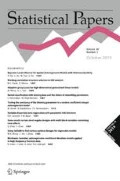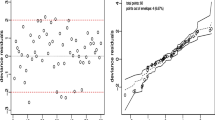Abstract
This paper considers non-parametric density estimation in the context of multiplicative censoring. A new estimator for the density function is proposed and consistency of the proposed estimator is investigated. Simulations are drawn to illustrate the results and to show how the estimator behaves for finite samples.






Similar content being viewed by others
References
Abbaszadeh M, Chesneau C, Doosti H (2012) Nonparametric estimation of density under bias and multiplicative censoring via wavelet methods. Stat Probab Lett 82:932–941
Abbaszadeh M, Chesneau C, Doosti H (2013) Multiplicative censoring: estimation of a density and its derivatives under the \(L_p\)-risk. REVSTAT Stat J 11(3):255–276
Andersen KE, Hansen MB (2001) Multiplicative censoring: density estimation by a series expansion approach. J Stat Plan Inference 98:137–155
Asgharian M, Carone M, Fakoor V (2012) Large-sample study of the kernel density estimators under multiplicative censoring. Ann Stat 82:932–941
Csörgő S (1985) Rates of uniform convergence for the empirical characteristic function. Acta Sci Math 48:97–102
Parzen E (1962) On estimation of a probability density function and mode. Ann Math Stat 33:1065–1076
Roenblatt M (1956) Remarks on some nonparametric estimates of a density function. Ann Math Stat 27:832–837
Stute W (1982) A law of the logarithm for kernel density estimators. Ann Probab 10(2):414–422
Stefanski LA, Carroll RJ (1990) Deconvoluting kernel density estimators. Statistics 21:169–184
Silverman BW (1986) Density estimation for statistics and data analysis. Chapman and Hall/CRC, London
Vardi Y (1989) Multiplicative censoring, renewal process, deconvolution and decreasing density: nonparametric estimation. Biometrika 76(4):751–761
Vardi Y, Zhang C-H (1992) Large sample study of empirical distributions in a random-multiplicative censoring model. Ann Stat 20:1022–1039
Wied D, Weißbach R (2010) Consistency of the kernel density estimator—a survey. Stat Pap 53(1):1–21
Author information
Authors and Affiliations
Corresponding author
Appendices
Appendix A: Proofs of the main results
Proof of Theorem 1
Under \({\mathbf {K(1)}},\) \(\mathbf {H(2)}\) and according to Lemma 7.1 we have
Let
be an ordinary kernel density estimator function of \(q\), that is defiend by (2.1), and based on the sample of \((T_1,\ldots ,T_n)\) where \(T_i=-\ln Z_i.\) An interchange of expectation and integration, justified by Fubini’s Theorem and \(\mathbf { K(3)},\) show that
Then it follows from (6.2) that
Thus \(q_{n}\) has the same bias as the ordinary kernel density estimator \(q^{*}_{n}\). \({\mathbf {K(1)}}, {{\mathbf {H(1)}}}\) and Lemma 7.1 follow
hence
Therefore from (6.1), (6.3) and Assumption \({\mathbf {P}}\), we have
Assumption \({{\mathbf {H(2)}}}\) and Lemma 7.2 follow that
By proof of Theorem 2.1 of Stefanski and Carroll (1990), \({\mathbf {K(2)-K(4)}}\) and \({\mathbf {H(1)}}\), we have
It can be easily seen that
so by combining (6.5), (6.6) we have
Finally, (6.4) and (6.8) complete the proof. \(\square \)
Proof of Theorem 2
It is easy to see that
From G(1), G(2), H(3), K(1) and Lemma 7.3 we have
For \(I_{2}\) first we have
Let \(W_i\) has density function \(f^*\) with characteristic function \(\Psi _{f^{*}}.\) Since \(\Psi _{K_{2}}\) is vanished out of \([-1,1]\), we have
where
hence
where
Lemma 7.4 implies that
hence using Assumption \({\mathbf {K(3)}}\) we have
Using \(\mathbf G(1) \) and \( \mathbf K(1) \),
Now (6.11), (6.13) and (6.14) yield
(6.9), (6.10), and (6.15) complete the proof. \(\square \)
Appendix B
In this section, we consider the kernel density estimator \(f_n\) of a univariate density \(f\) introduced by Roenblatt (1956),
where \(\xi _{1},\xi _{2},\ldots ,\xi _{n}\) are independent observations from distribution \(F\) with density function \(f\). \(K,\) \(a_n\) and \(F_n\) are kernel function, a bandwidth and empirical distribution function, respectively. Also, the characteristic function of \(f\) and its empirical are denoted by
and
Lemma 7.1
(Corollary 1A, Parzen (1962)). The estimator defined by (7.1) is asymptotically unbiased at all points \(x\) at which the probability density function is continuous if the constants \(a_{n}\) satisfy \(\lim _{n \longrightarrow \infty }a_{n}=0\) and if the function \(K(\cdot )\) satisfies
and
\(\square \)
Lemma 7.2
(Theorem 2A, Parzen (1962)) The estimates defined by (7.1) have variances satisfying
at all points \(x\) of continuity of \(f(x),\) if \(\lim _{n \longrightarrow \infty } a_{n}=0\) and the function \(K\) satisfies (7.2) and (7.3). \(\square \)
Lemma 7.3
(Theorem 1.2., Stute (1982)) Let \(K\) be of bounded variation and suppose that \(K(x)=0\) outside some finite interval \([r,s)\). If
with \(J=(a, b),\) then for each \(\epsilon >0\) and every bandsequence \((a_{n})\), where \(\lim _{n\rightarrow \infty }\) \(a_{n}=0\) and \(\lim _{n \rightarrow \infty }\frac{\ln ({a^{-1}_{n}})}{na_{n}}=0,\) we have
where \(J_{\epsilon }=(a+\epsilon , b-\epsilon )\) and \(C\) is a constant. \(\square \)
Lemma 7.4
(Example (1), Csörgő (1985)) Suppose that \(P\left( |\xi |>x\right) \le Lx^{-\alpha }\) for all large enough \(x,\) where \(L\) and \(\alpha \) are arbitrary positive constants. Then for any \(A>0\)
where \(C\) is a positive constant and
for any extended number \(0<T\le \infty \). \(\square \)
Rights and permissions
About this article
Cite this article
Zamini, R., Fakoor, V. & Sarmad, M. On estimation of a density function in multiplicative censoring. Stat Papers 56, 661–676 (2015). https://doi.org/10.1007/s00362-014-0602-x
Received:
Revised:
Published:
Issue Date:
DOI: https://doi.org/10.1007/s00362-014-0602-x




